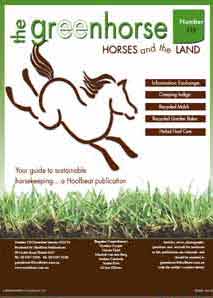The Green Horse section provides practical information on managing environmentally sustainable horse properties, readers stories and tips, as well as advice and articles from equestrian experts in their fields.
August/September 2016
Vol 38 No 2
In this issue of The Green Horse you will find the following articles:
Information Exchange - Glyphosate and a By-Pass Gate
Mouldy Hay - by Kentucky Equine Research.
The Cold Season
by Angela Davison - The Horse Herbalist
Deeds, Steeds Weeds - Rabbit Control, Qld Tick Line
Arena Dust Part 2 by Sarah Jackson
Part 2 - The likelihood of respiratory irritation in horses and people who spend time in equestrian environments, from inorganic dust, is not well understood.
Wash Bay Design
Just what is involved with designing a wash bay that is practical for your budget and property design, yet works well for your horse and your equestrian lifestyle.
Basic functional design of wash bay
Luxury wash bay design
WIN A YEAR'S SUBSCRIPTION...
share your equine related recycling ideas and each issue one reader will win.
Send ideas to Rebecca -
The Green Horse Support <thegreenhorse.assistant@gmail.com>

|
  
  

MOULDY HAY

Mouldy forage can contribute to a range of disorders in the horse. Inhaled fungal and actinomycete spores can cause primary allergic and inflammatory respiratory disease, as well as influencing the incidence, severity, and duration of episodes of infectious respiratory disease.
However, molds may also produce toxic secondary metabolites called mycotoxins. Mycotoxins may contribute to reproductive, immunological, respiratory, gastrointestinal, and other disorders in livestock including the horse. Mycotoxins can behave as immunosuppressants, thus having the possibility to contribute to secondary disorders.
Mould and subsequent mycotoxin contamination of a forage can increase during extreme environmental conditions such as high humidity at the time of baling or from mechanical damage to the forage.
Fusarium mycotoxins include vomitoxin (deoxynivalenol or DON), zearalenone, fumonisins, moniliformin, and fusarin C. There is evidence of synergism between mycotoxins, one example being between vomitoxin and fusaric acid (a phytotoxin). Signs of toxicity are induced at much lower levels of exposure when these two toxins are ingested together than when ingested separately.
Zearalenone, an ostrogenic toxin, can lead to reproductive problems including hyperestrogenism. Disorders seen in swine and horses include uterine enlargement and inflammation and atrophy of the ovaries. It has not been shown to cause abortions.
Vomitoxin, one of the most frequent tricothecene contaminants found on cereal crops, has been associated with loss of appetite, vomiting, lesions of the intestinal tract, immunosuppression, lethargy, and ataxia in domestic animals and man. Studies have shown the presence of potentially significant levels of vomitoxin in hay being fed to horses.
This was in hay that owners were happy with, based on visual inspection. The levels found in this study could potentially have an influence on the health of horses consuming such hay. The threshold of significant biological activity is unknown for the horse; however, chronic exposure to lower levels rather than acute exposure to high levels may contribute to a wide range of disorders.
To minimise problems with mouldy hay, buy from a reputable producer, store hay so that it is protected from moisture, allow air circulation around stored hay, and check each bale for visible mould before feeding.
|